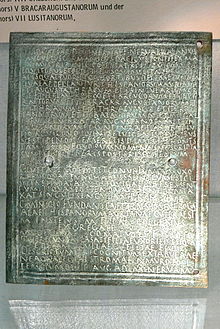Cohors I Breucorum
The Cohors I Breucorum [civium Romanorum] [Antoniniana] [Valeria Victrix] [bis torquata] [ob virtutem appellata] [equitata] ( German 1st cohort of the Breuker [the Roman citizens] [the Antoninian] [the strong and victorious] [ twice awarded with torques ] [awarded for bravery] [partially mounted] ) was a Roman auxiliary unit . It is evidenced by military diplomas and inscriptions.
Name components
- Breucorum : [the] Breuker . The soldiers of the cohort were in the field of in formation of the unity of the Illyrian people of Breuker Roman province of Pannonia recruited.
- civium Romanorum : the Roman citizen or with Roman citizenship . The soldiers of the unit had been granted Roman citizenship at one point in time. However, this did not apply to soldiers who were accepted into the unit after this point in time. They received Roman citizenship only with their honorable farewell ( Honesta missio ) after 25 years of service. The addition occurs in military diplomas from 116 to 159/160.
- Antoniniana : the Antoninian. An honorary title that refers to Caracalla (211-217). The addition occurs in the inscriptions ( CIL 3, 11934 , CIL 3, 11935 ).
- Valeria Victrix : the strong and victorious. The addition occurs in the inscriptions ( CIL 3, 11931 , CIL 3, 11932 ).
- to torquata : awarded twice with torques . The addition occurs in the inscriptions ( CIL 3, 11931 , CIL 3, 11932 ). Along with the Cohors I Lepidiana and the Cohors III Thracum , the unit is one of the 3 auxiliary troop cohorts to receive this award.
- ob virtutem appellata : awarded for bravery. The addition occurs in the inscriptions ( CIL 3, 11931 , CIL 3, 11932 ).
- equitata : partially mounted. The unit was a mixed association of infantry and cavalry. The addition appears in the inscription ( CIL 5, 875 ).
Since there is no evidence of the addition of milliaria (1000 men) to the name , the unit was a Cohors (quingenaria) equitata . The nominal strength of the cohort was 600 men (480 infantry and 120 horsemen), consisting of 6 centuries of infantry with 80 men each and 4 tower cavalry with 30 horsemen each.
history
The cohort was stationed in Raetia Province . It is listed on military diplomas for the years AD 86 to 167/168.
The unit was probably set up under Augustus due to the Pannonian uprising . It was probably stationed in the province of Germania in the early Flavian period .
The first evidence in Raetia is based on a military diploma which is dated to the year 86 AD. In the diploma, the cohort is listed as part of the troops (see Roman Armed Forces in Raetia ) that were stationed in the province. Further diplomas, dated from 107 to 167/168, prove unity in the same province.
The last evidence of unity is based on the inscriptions ( CIL 3, 11934 , CIL 3, 11935 ) which are dated to 211.
Locations
Cohort locations in Raetia may have been:
- Böhming : The commander of the 1st Breukerkohort from Pfünz, Aelius Fortis, who was also the centurion of the III. Italian Legion, led the final work on the stone extension of the fort, which was completed in 181 AD.
- Burghöfe : The unit may have been stationed in Burghöfe between 41/54 and 106/117.
- Nassenfels : The unit could have been garrisoned here in Domitian times around 90 AD until it was moved forward to Pfünz.
- Pfünz : The unit was probably stationed in Pfünz until the Raetian Limes was surrendered around 254.
Members of the cohort
The following members of the cohort are known.
Commanders
|
|
Others
See also
Web links
Individual evidence
- ^ A b c d e John Spaul: Cohors² The evidence for and a short history of the auxiliary infantry units of the Imperial Roman Army . In: British Archaeological Reports , 2000, ISBN 978-1-84171-046-4 , pp. 315, 317-319; BAR International Series (Book 841)
- ^ Jörg Scheuerbrandt : Exercitus. Tasks, organization and command structure of Roman armies during the imperial era. Dissertation, Albert-Ludwigs-Universität Freiburg im Breisgau 2003/2004, p. 160 Table 4, uni-freiburg.de (PDF; p. 162).
- ↑ a b c d Farkas István Gergő: The Roman Army in Raetia Dissertation, University of Pécs Faculty of Humanities 2015, pp. 147–148, 244–259, 393–403 ( idi.btk.pte.hu ( Memento of the original from December 14, 2016 in the Internet Archive ) Info: The archive link has been inserted automatically and has not yet been checked. Please check the original and archive link according to the instructions and then remove this notice. (PDF; 19.1 MB, pp. 150–151, 396– 406)).
- ↑ Military diplomas of the years 86 ( AE 2007, 1782 ), 107 ( CIL 16, 55 ), 116 ( RMD 3, 155 , RMD 4, 229 ), 121/125 ( RMD 1, 25 ), 125/128 ( RMD 1, 32 ), 129/136 ( AE 2005, 1150 ), 140/147 ( RMD 3, 166 ), 153/157 ( CIL 16, 117 ), 154/161 ( RMD 3, 175 ), 156/157 ( CIL 16, 183 ), 157 ( RMD 1, 51 , RMD 3, 170 , RMM 00038), 159/160 ( AE 2005, 1153 ), 160 ( RMD 4, 278 ), 161/163 ( RMD 2, 112 ), 166 ( CIL 16, 121 ) and 167/168 ( RMD 1, 168 ).
- ↑ CIL 03, 14370 .
- ↑ Wolfgang Czysz , Lothar Bakker a . v. a .: The Romans in Bavaria . Theiss, Stuttgart 1995, ISBN 3-8062-1600-2 , p. 136.
- ↑ CIL 03, 11930 , CIL 03, 11933 , CIL 03, 05918 .

